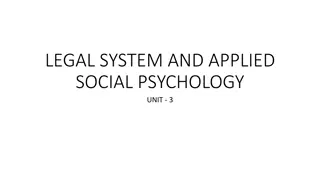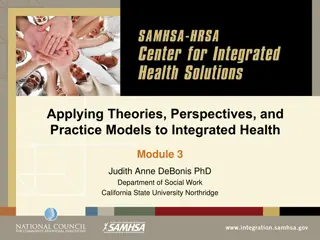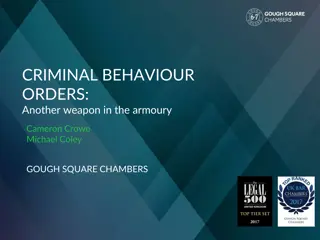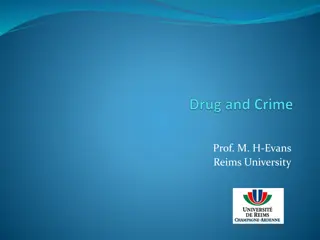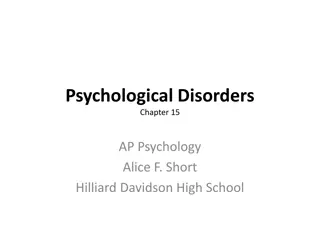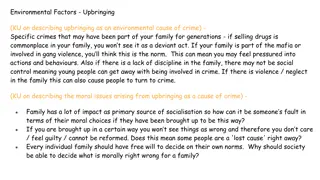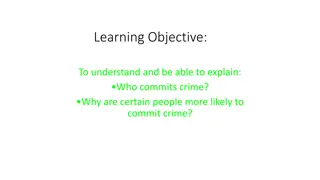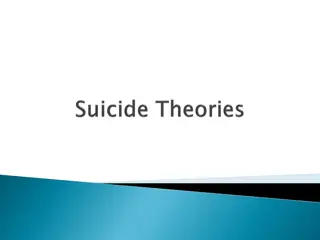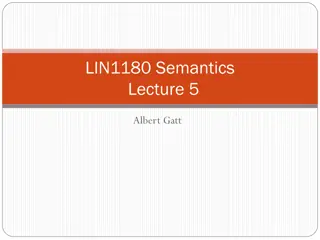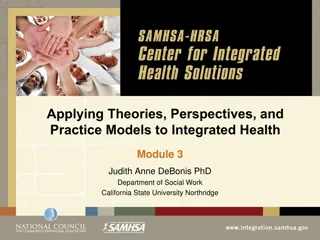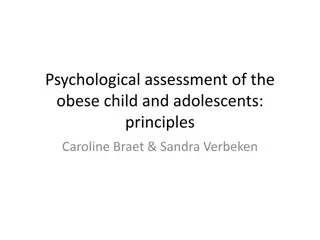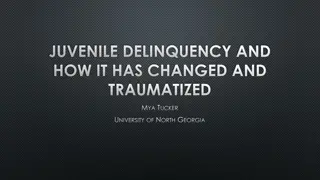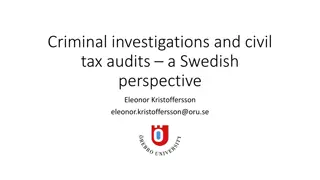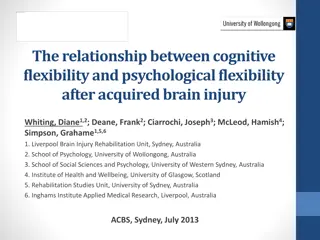Understanding Psychological Theories of Criminal Behavior
Psychologically-based criminologists attribute criminal behavior to individual factors such as negative early childhood experiences and inadequate socialization, leading to criminal thinking patterns and incomplete cognitive development. Probation and parole practices are influenced by rehabilitation processes designed from psychological theories, particularly Social Learning Theory and Psychoanalytic Perspective. These theories emphasize the importance of personal, environmental, and behavioral factors in shaping human behavior, highlighting the impact of observational learning stages and the influence of early childhood experiences on criminal behavior.
Download Presentation

Please find below an Image/Link to download the presentation.
The content on the website is provided AS IS for your information and personal use only. It may not be sold, licensed, or shared on other websites without obtaining consent from the author. Download presentation by click this link. If you encounter any issues during the download, it is possible that the publisher has removed the file from their server.
E N D
Presentation Transcript
PSYCHOLOGICAL CRIMINOLOGY Psychologically-based criminologists explain criminal behavior as the consequence of individual factors, such as negative early childhood experiences and inadequate socialization, that result in criminal thinking patterns and/or incomplete cognitive development. Focus on individual problems Psychological theories of criminal behavior have had the most direct influence on probation and parole practice. Rehabilitation processes designed from one or more psychological theories. (Reference #1)
THEORIES SOCIAL LEARNING PSYCHOANALYTIC CRIMINOLOGY PERSONALITYBEHAVIOR FRUSTRATION-AGGRESSION COGNITIVE
SOCIAL LEARNING THEORY (1 OF 3) Bandura (1971) Social Learning Theory is a cognitive and behavioral theory that explains human behavior through the interaction of personal (cognitive), environmental, and behavioral factors in a social setting. A person s behavior is influenced by his or her environment as well as inherent personal traits A person s environment is influenced by the presence of and interaction with that person s behaviors and traits Personal traits are influenced by both behavior and the environment. (Reference #3)
SOCIAL LEARNING THEORY (2 OF 3) Observational learning comprises four distinct cognitive stages: Attention - actively observing the behavioral model Retention - storing new information to be retrieved at a later time Reproduction - recreating modeled behavior in order to practice it Motivation - feeling compelled to continue the behavior in the future (Reference #3)
SOCIAL LEARNING THEORY (3 OF 3) Albert Bandura (1960s) Social learning theory - aggressive behavior is learned and focused on the process of learning through observation or by example either intentionally or accidentally Individuals will learn how to act, feel, behave based on what they learn from watching others. Bobo doll experiment: https://www.Youtube.Com/watch?Time_continue=11&v=pr0otcvthbu Bobo doll experiment explained: Https://www.Youtube.Com/watch?V=zerck0lrjp8 (Reference #5)
PSYCHOANALYTIC PERSPECTIVE THE PSYCHOTIC OFFENDER FRUSTRATION AGGRESSION THEORY ATTACHMENT THEORY
PSYCHOANALYTIC CRIMINOLOGY Psychoanalytic theories assume that negative early childhood experiences may increase the probability of criminal behavior. (Reference #1)
CRIMINALITY PERSONALITY (1 OF 2) Assume that offenders have developed criminal thinking patterns that are distinct from those of non-offenders. The root causes of crime are not...Social issues [high unemployment, bad schools] but deeply ingrained features of the human personality and its early experiences. Low intelligence, an impulsive personality, and a lack of empathy for others are leading characteristics of people at risk for becoming offenders (Reference #1)
CRIMINALITY PERSONALITY (2 OF 2) Hans Eysenck (1987) theorizes that criminal behavior may be a function of both personality differences (i.e., Offenders are more likely to be neurotic and extroverted) and conditioning, Some individuals are simply more difficult to condition than others. We develop a conscience through conditioning, antisocial behavior is more likely when this process breaks down. (Reference #1)
PERSONALITY THEORIES (1 OF 2) Antisocial Personality Disorder The Trait Theory Psychopath
PERSONALITY THEORIES (2 OF 2) Personality - individual differences in characteristic patterns of thinking, feeling, and behaving Personality traits- A tendency to behave, feel, perceive, and think in relatively consistent ways across time and across situations in which the trait may be manifest. Personality profiles in childhood generally are very similar profiles in adulthood. Individuals who become more dominant, conscientious, interpersonally sensitive, and emotionally stable across time become a functioning member of society (Reference #4)
TRAIT THEORY (1 OF 4) The Big Five Personality Traits (OCEAN) The Big Five Personality Inventory contains 50 statements, ten questions that address each personality factor, and each response is indicated on a five-point Likert scale which ranges from strongly disagree to strongly agree. This test scores each factor on a scale of 0 to 40. These facets help to define and expand on each factor and provide a fuller picture of the individual s personality. Take the test! Click the link to view the Personality Test - https://www.123test.Com/personality-test/ Psychometrics Information available at this link - https://openpsychometrics.org/tests/IPIP-BFFM/ Now let s look at the different facets (Reference #4)
TRAIT THEORY (2 OF 4) Openness to experience High scorers Like to learn new things and have new experiences display traits such as imagination, artistic interests, depth of emotion, willingness to experiment, intellectual curiosity, and tolerance for diversity. Low scorers Traditional, down to earth, conservative, and practical. (Reference #4)
TRAIT THEORY (3 OF 4) Conscientiousness - sense of competence orderliness, sense of responsibility, achievement striving, self- discipline, and deliberateness High Scores reliable and prompt, disciplined, efficient, well organized, and having a strong sense of duty. Low scorers can be described as spontaneous, disorganized, preferring flexible plans, and disliking precise details. Extraversion - warmth, gregariousness, assertiveness, activity level, excitement seeking, and positive emotions High Scorers (Extroverts) get energy from interacting with others, outgoing, friendly, assertive, like working with others, and enjoy leadership roles Low scores (introverts) get energy from themselves, reserved, formal, serious, quiet, prefer working alone, and avoid leadership roles. (Reference #4)
TRAIT THEORY (4 OF 4) Agreeableness - trust in others, sincerity altruism, compliance, modesty, and sympathy High Scorers friendly, cooperative, and compassionate, warm, eager to please, and good-natured. Low scorers distant, hard-headed, skeptical, competitive, and proud. Neuroticism - anxiety, angry hostility, moodiness/contentment, self-consciousness, self-indulgence, and sensitivity to stress individual s emotional stability and degree of negative emotions. High scorers prone to worry, easily upset, and experiencing negative emotional reactions and feelings of anxiety. Low scorers relaxed, resilient, calm, and not easily upset in stressful situations. (Reference #4)
THE PSYCHOPATH Nathaniel Thorton (1951-1952) Psychopathic personality - apparent absence of common moral and ethical sensibility, or the ability to make a fundamental distinction between what is right and what is wrong according to the generally accepted criteria adopted by society Additional characteristics Eccentricities of one sort or another Indifference to social demands and unawareness of social responsibilities Flagrant disregard of the needs and rights of other people Excessive selfishness and overweening egocentricity Failures in attempts at adaptation Vagrancy, instability, shiftlessness (Reference #2)
ANTISOCIAL PERSONALITY THEORY (1 OF 2) Sociopathy - focused on the behavioral aspects of the disorder Psychopathy - looked into the cognitive and personality traits Antisocial personality disorder - mental illness that often prevents people from conforming to social norms and facing negative impacts on their daily lives as a result. Inability to sustain consistent work behavior, lack of ability to respond as a responsible parent, failure to accept social norms with respect to the law, inability to maintain enduring attachment to a sexual partner, irritability and aggressiveness, failure to honor financial obligations, failure to plan ahead, disregard for honesty, and recklessness (Reference #6)
ANTISOCIAL PERSONALITY THEORY (2 OF 2) Most people diagnosed with the disorder are being treated against their will, most likely because they are in prison. The recidivism rate for people diagnosed with antisocial personality disorder is quite high, and many forms of therapy may not be sufficient to reduce antisocial behaviors and personality traits. (Reference #6) (Attribution #1)
FRUSTRATION-AGGRESSION THEORY Aggression - a reaction to environmental conditions, namely those conditions provoking frustration. Frustration - an interference with the occurrence of an instigated goal- violence and aggression response at its proper time in the behavior sequence" (reference #5) Frustration-aggression hypothesis - aggression is a response to frustration and it always emerges from frustration. "frustration always leads to some form of aggression" (Reference #5)
CRIMINAL PROFILE FRUSTRATION-AGGRESSION THEORY LT. WILLIAM CALLEY March 16th , 1968 The massacre of Vietnamese civilians, including women and children, at My Lai On. Found guilty of killing 22 civilians - 10 year sentence Following the frustration aggression theory - questionnaires indicated that the level of aggression of the participants increased due to the fear and frustration provoked by the war. "War is not caused by human aggressiveness, or that people fight in war because they are aggressive" but rather the frustration emerges from situations of violence and war, which then leads to aggression. (Reference #5)
ATTACHMENT THEORY (1 OF 3) Attachment is a deep and enduring emotional bond that connects one person to another across time and space One person may have an attachment to an individual which is not shared. Attachment is characterized by specific behaviors in children, such as seeking proximity to the attachment figure when upset or threatened John Bowlby (1958) Attachment Theory explains how the parent-child relationship emerges and influences subsequent development Harry Harlow's monkeys attachment experiment (See video) (Reference #8) (Attribution #2)
ATTACHMENT THEORY (2 OF 3) Secure Attachment Anxious-avoidant Attachment Anxious-resistant Attachment
ATTACHMENT THEORY (3 OF 3) 1. Secure attachment - children feel confident that the attachment figure will be available to meet their needs. Attachment figure used as a safe base to explore the environment and seek the attachment figure in times of distress. 2. Anxious-avoidant attachment - insecure avoidant children do not orientate to their attachment figure while investigating the environment. They are very independent of the attachment figure both physically and emotionally. They do not seek contact with the attachment figure when distressed. Have a caregiver who is insensitive and rejecting of their needs. The child will commonly exhibit clingy and dependent behavior, but will be rejecting of the attachment figure when they engage in interaction. 3. Anxious-resistant attachment - child fails to develop any feelings of security from the attachment figure Difficulty moving away from the attachment figure to explore novel surroundings. When distressed they are difficult to soothe and are not comforted by interaction with the attachment figure. This behavior results from an inconsistent level of response to their needs from the primary caregiver. (Reference #9)
COGNITIVE THEORIES MORAL DEVELOPMENT THEORY, CRIMINAL MINDSET
MORAL DEVELOPMENT THEORY Cognitive development theories link criminal behavior to failure to develop a moral judgement. Morality - recognition of the distinction between good and evil or between right and wrong; respect for and obedience to the rules of right conduct; the mental disposition or characteristic of behaving in a manner intended to produce good results Kohlberg observed that we learn morality from those we interact with on a regular basis our family, friends, and others in the community. (Reference #1 & 10)
MORAL DEVELOPMENT THEORY (2 OF 2) Kohlberg found that moral reasoning (i.e., Our capacity to do the right thing ) develops in three stages: 1. Preconventional stage, children (age 9-11) think, if I steal, what are my chances of getting caught and punished? 2. Conventional stage, adolescents (age 12-19) think it is illegal to steal and therefore I should not steal, under any circumstances. 3. Post-conventional stage(adults over 20 years old), critically examine customs and social rules according to their own sense of universal human rights, moral principles, and duties
CRIMINAL PROFILE MORAL DEVELOPMENT THEORY CARLO GAMBINO CRIME FAMILY 2017 New York Charging four defendants with narcotics trafficking, loansharking and firearms offenses. The defendants Damiano Zummo, an acting captain in the Bonanno crime family Salvatore Russo, an associate of the Bonanno crime family Paul Semplice, a member of the Gambino crime family Paul Ragusa, an associate of the Bonanno and Gambino crime family Moral development theory argues that individuals learn their morals from their close friends and families. Being involved in a family of criminal, and friends who are like family, can effect the way in which an individuals morals are developed over time. (Reference #7)
REFERENCES 1. https://www.uscourts.gov/sites/default/files/80_3_2_0.pdf 2. https://pdfs.semanticscholar.org/6516/ced8604db72c0cbbb127538750310e7363fd.pdf 3. file:///c:/users/katiecali/work%20folders/desktop/downloads/22942-article%20text-54793-1-10-20170612.pdf 4. https://stars.library.ucf.edu/cgi/viewcontent.cgi?referer=https://www.google.com/&httpsredir=1&article=1270&context=honorstheses 5. https://pdfs.semanticscholar.org/6fdf/a7d48d044429a83a9185188ac2e921fe5687.pdf 6. https://opensiuc.lib.siu.edu/cgi/viewcontent.cgi?article=1795&context=gs_rp 7. https://www.justice.gov/usao-edny/pr/members-and-associates-gambino-and-bonanno-organized-crime-families-arrested 8. https://www.simplypsychology.org/attachment.html 9. https://www.simplypsychology.org/mary-ainsworth.html 10. http://oer2go.org/mods/en-boundless/www.boundless.com/psychology/textbooks/boundless-psychology-textbook/human-development-14/theories-of-human-development-70/kohlberg-s-stages-of-moral-development-268- 12803/index.html 11. https://www.townandcountrymag.com/society/money-and-power/a12231370/menendez-brothers-murders-trial-why-they-did-it-story/ KATIE CALI, INSTRUCTOR OF SOCIOLOGY AND CRIMINAL JUSTICE, AT NORTHSHORE TECHNICAL COMMUNITY COLLEGE. THIS WORK IS LICENSED UNDER THE CREATIVE COMMONS ATTRIBUTION (CC-BY) LICENSE. TO VIEW A COPY OF THE LICENSE, VISIT HTTPS://CREATIVECOMMONS.ORG/LICENSES/BY/4.0/
ATTRIBUTIONS 1. https://youtu.be/hzm-RsIzsuM 2. https://youtu.be/_O60TYAIgC4




